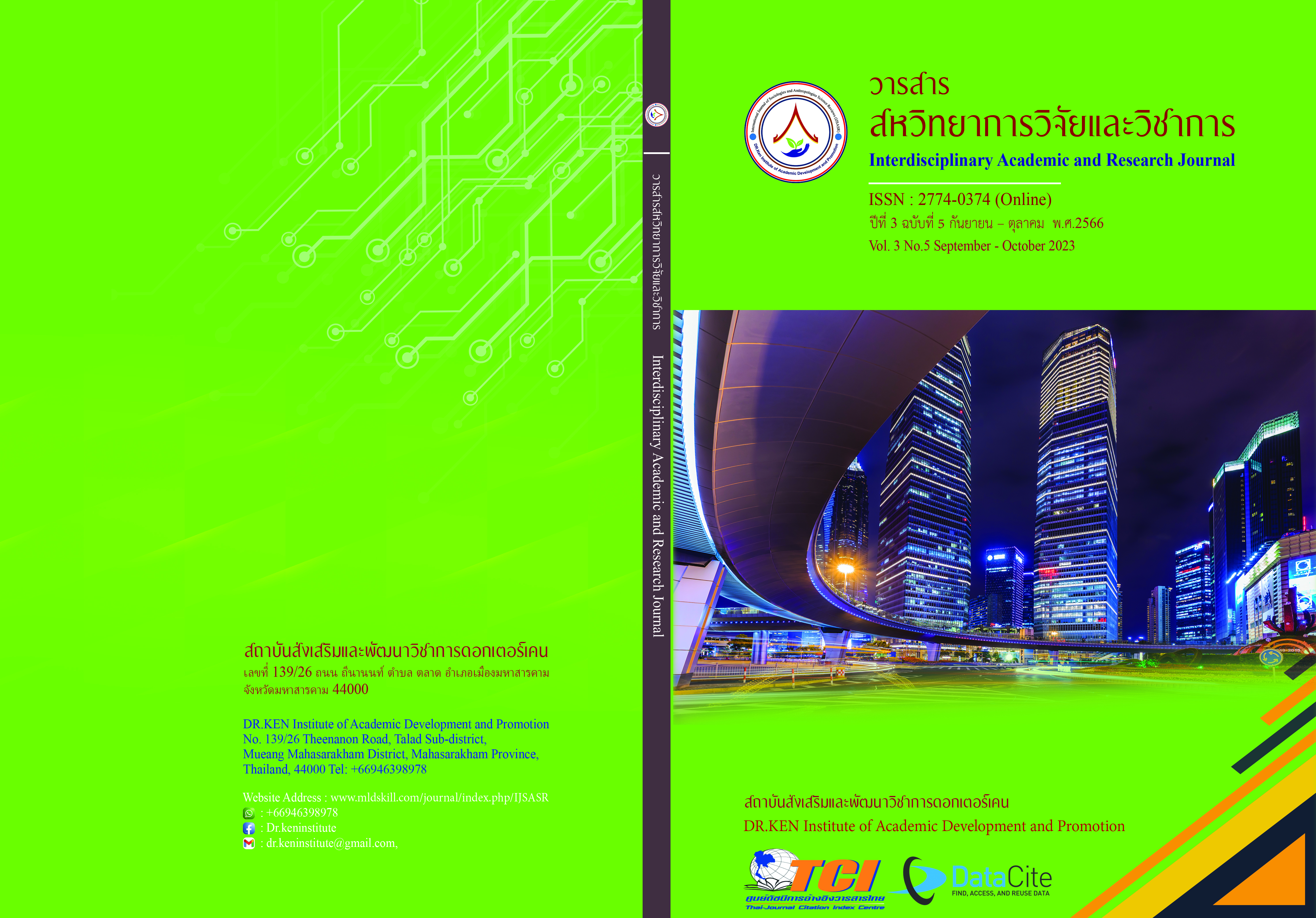Guidelines for the Development of High-level Thinking of Mathayomsuksa 1 Students
DOI:
https://doi.org/10.14456/iarj.2023.258Keywords:
Advanced Thinking Development Guidelines; , Advanced Thinking; , Mathematical Problem Solving; , Mathematical Critical Thinking;, Mathematical ReasoningAbstract
Problems in advanced thinking of Mathayomsuksa 1 students, Wapi Pathum School, the academic year 2022, which the researcher has foreseen the problems that arise. Therefore, the researcher is interested in studying methods for developing higher thinking. The objectives of this research were (1) to study the high-level thinking of Mathayomsuksa 1 students, (2) to study guidelines for developing high-level thinking of Mathayomsuksa 1 students, a sample of Mathayomsuksa 1 students. 1 Wapi Pathum School, a total of 238 students. The research tools were mathematical problem-solving tests. mathematical analytical thinking test math reasoning quiz and a semi-structured interview. The statistics used in the research were mean and standard deviation. Task Analysis and Analytic Description. The results showed that (1) Higher level thinking of Mathayomsuksa 1 students at Wapi Pathum School found analytical thinking according to Marzano's approach. can be divided into 5 aspects as follows: 1) Comparison Students scored 3 points, equivalent to 48.31 percent. 2) Identification, students scored 3 points, equivalent to 44.11 percent. 3) Analysis of errors. Students scored 3 points, equivalent to 50.42%. 4) Summary of principles Students scored 3 points, representing 40.33 percent, and 5) the aspect of the application. Students scored 3 points, representing 52.52%. (2) Results of a study of reasoning for Mathayomsuksa 1 students at Wapi Pathum School Reasoning for Mathayomsuksa 1 students, most of the students were at the moderate level with 120 students, representing 50.42%. (3) The results of a study of problem-solving of Mathayomsuksa 1 students at Wapi Pathum School found that the problem-solving of Mathayomsuksa 1 students was at a good level with 110 students representing 46.21%.
References
กมลพร ทองธิยะ. (2563). การพัฒนาการคิดขั้นสูง: ความสามารถทางสติปัญญาที่สำคัญในโลกยุค New Normal. วารสารศึกษาศาสตร์ มหาวิทยาลัยศิลปากร, 19 (2),28-44.
ยุพิน พิพิธกุล. (2545). การสอนคณิตศาสตร์. กรุงเทพฯ: คณะครุศาสตร์ จุฬาลงกรณ์มหาวิทยาลัย
ราชบัณฑิตยสภา. (2558). พจนานุกรมศัพท์ศึกษาศาสตร์ร่วมสมัย ฉบับราชบัณฑิตยสภา.กรุงเทพฯ: สำนักราชบัณฑิตยสภา.
สถาบันส่งเสริมการสอนวิทยาศาสตร์และเทคโนโลยี. (2555). การวัดผลประเมินผลคณิตศาสตร์. กรุงเทพฯ: ซีเอ็ดยูเคชั่น
สมเดช บุญประจักษ์. (2540). การศึกษาความสามารถในการให้เหตุผลทางคณิตศาสตร์โดยการจัดการเรียนการสอนที่เน้นการใช้คำถามปลายเปิดของนักเรียนชั้นมัธยมศึกษาปีที่ 1. ปริญญานิพนธ์ กศ.ด. สาขาคณิตศาสตร์ศึกษา. มหาวิทยาลัยศรีนครินทรวิโรฒ.
อังคณา อ่อนธานี. (2564). การพัฒนาสมรรถนะการจัดการเรียนรู้ของครูเพื่อส่งเสริมการคิดขั้นสูง สำหรับผู้เรียนชั้นมัธยมศึกษา. วารสารศึกษาศาสตร์ มหาวิทยาลัยนเรศวร. 23(4), 406-418.
อัมพร ม้าคนอง. (2534) การเปรียบเทียบผลสัมฤทธิ์ทางการเรียนคณิตศาสตร์ ของนักเรียนระดับชั้นมัธยมศึกษาปีที่ 3 ที่เลือกใช้พฤติกรรมด้านพุทธิพิสัยในการแก้ปัญหาทางคณิตศาสตร์แตกต่างกัน. กรุงเทพฯ: จุฬาลงกรณ์มหาวิทยาลัย.
Adams, S., Leslie, C.E., & Beeson, B.F. (1977). Teaching Mathematics with Emphasis on the Diagnostic Approach. New York: Harper & Row.
Barnett, M. A. (1988). Reading through Context: How Real and Perceived Strategies Use Affects L2 Comprehension. Modern Language Journal, 72, 150-162. https://doi.org/10.1111/j.1540-4781.1988.tb04177.x
Baroody, A.J. (1993). Problem Solving, Reasoning, and Communicating (K-8): Helping Kids Think Mathematically. New York, NY: Macmillan.
Căprioară, D. (2014). Problem Solving - Purpose and Means of Learning Mathematics in School. Procedia - Social and Behavioral Sciences. 191 (2), 1859-1864. https://doi.org/10.1016/j.sbspro.2015.04.332
Hannah, L. S., & Michaelis, J. U. (1977). A Comprehensive Framework for Instructional Objectives: A Guide to Systematic Planning and Evaluation. Reading, MA.: Addison Wesley.
Haryono, A., & Tanujaya, B. (2018). Profil kemampuan penalaran induktif mahasiswa pendidikan matematika unipa ditinjau dari gaya belajar. Journal of Honai Math, 1(2), 127-138. https://doi.org/10.30862/jhm.v1i2.1049
Lasher, E.B., (1972). Educational Media Attitude of and Competencies for Element Teacher. Dissertation Abstract International. 32 (June 1972): 6837 A-6938 A).
Lidya Putri Apriliana, P.L., & Handayani, I., & Awalludin, A.S., (2019). The Effect of a Problem-Centered Learning on Student’s Mathematical Critical Thinking. Journal of Research and Advances in Mathematics Education. 4 (2), 124-133, July 2019 http://journals.ums.ac.id/index.php/jramathedu
Mumu, J., Prahmana, R.C.I. & Tanujaya, B. (2018). Construction and reconstruction concept in mathematics education. J. Phys.: Conf. Ser, 943, 012011. https://doi.org/10.1088/1742-6596/943/1/012011
Mumu, J., Prahmana, R.C.I. & Tanujaya, B., (2019) Measure Reasoning Skill of Mathematics Students. International Journal of Higher Education. 18 (6), 85-91. https://doi.org/10.5430/ijhe.v8n6p85
Niswah, U., & Qohar, A., (2020). Mathematical Reasoning in Mathematics Learning on Pyramid Volume Concept found that problem-solving learning can improve students' mathematical abilities and comprehension. Malikussaleh Journal of Mathematics Learning (MJML). 3 (1), 23-26. DOI: https://doi.org/10.29103/mjml.v3i1.2400
Polya, G. (1957). How to Solve It. A New Aspect of Mathematical Method. 2nd Edition, Princeton University Press, Princeton.
Qolfathiriyus, A., Sujadi, I., & Indriati, D., (2018). Students’ Analytical Thinking Profile Based on Reflective Cognitive Style in Solving Mathematics Problems. IOP Conf. Series: Journal of Physics: Conf. Series 1306 (2019) 012016 IOP Publishing, doi:10.1088/1742-6596/1306/1/012016
Robert J. Marzano. (2001). Designing A New Taxonomy of Educational Objectives. California: Corwin Press, Inc.
Sternberg, R. J. (1997). The concept of intelligence and its role in lifelong learning and success. American Psychologist, 52(10), 1030–1037. https://doi.org/10.1037/0003-066X.52.10.1030
Sukmaningthias, N., (2016). Improve Analytical Thinking Skill and Mathematical Representation of The Students Through Math Problem Solving. PROCEEDING OF 3RD INTERNATIONAL CONFERENCE ON RESEARCH, IMPLEMENTATION AND EDUCATION OF MATHEMATICS AND SCIENCE YOGYAKARTA, 16 – 17 MAY 2016.
Tanujaya, B., (2014). Development of an Instrument to Measure Higher Order Thinking Skills in Senior High School Mathematics Instruction. JISAE JOURNAL OF INDONESIAN STUDENT ASSESSMENT AND EVALUATION. 7 (21), DOI:10.21009/JISAE.011.05
Tanujaya, B., Mumu, J., & Margono, G., (2017). The Relationship between Higher Order Thinking Skills and Academic Performance of Student in Mathematics Instruction. International Education Studies. 10 (11), 78-85. doi:10.5539/ies.v10n11p78
Yamane, T., (1973). Statistics: an introductory analysis. New York: New York: Harper & Row.
Downloads
Published
How to Cite
Issue
Section
License
Copyright (c) 2023 Vainda Bubpadah, Navapon Nontapa

This work is licensed under a Creative Commons Attribution-NonCommercial-NoDerivatives 4.0 International License.
Copyright on any article in the Interdisciplinary Academic and Research Journal is retained by the author(s) under the under the Creative Commons Attribution-NonCommercial-NoDerivatives 4.0 International License. Permission to use text, content, images, etc. of publication. Any user to read, download, copy, distribute, print, search, or link to the full texts of articles, crawl them for indexing, pass them as data to software, or use them for any other lawful purpose. But do not use it for commercial use or with the intent to benefit any business.
















.png)


